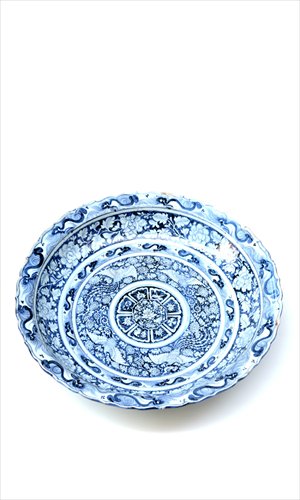In blue and white

A dish with motifs of the legendary phoenix, and peonies and chrysanthemums on a white and blue background; a model of a Mongolian yurt containing lotus scrolls and auspicious wonders; and a blue-and-white vase with a dragon sailing through clouds containing an inscription from the 11th year of Zhizheng Reign (1351) of the Yuan Dynasty (1279-1368). These are examples of ancient treasures that left China a long time ago. But now these items are back in China and on display at the Shanghai Museum.
Entitled Splendors in Smalt: Art of Yuan Blue-and-White Porcelain the exhibition is ongoing at the Shanghai Museum and features some 90 examples of Yuan Dynasty blue-and-white porcelain works garnered from more than 30 museums and galleries from both China and abroad.

Treasures from afar
The National Museum of Iran is the second largest repository of Yuan Dynasty blue-and-white porcelain in the world, after the Topkapı Sarayı Müzesi in Istanbul. And this Tehran museum has loaned 10 of their 32 Chinese pieces to this exhibition. Meanwhile, the Percival David Foundation of Chinese Art and the British Museum have also provided significant blue-and-white porcelain pieces for the exhibition. The aforementioned blue-and-white dragon vase is regarded as a milestone in the development of this type of porcelain. In the 1950s an American academic, Dr John Alexander Pope, was the first person to correctly identify the provenance and history of blue-and-white porcelains in Iran and Turkey as original Yuan Dynasty works.
Also on view are rarely seen blue-and-white porcelains that depict historical stories. One such is a jar that depicts an image of Wang Zhaojun, the imperial palace maid who was dispatched to marry a provincial leader in the west of China during the Han Dynasty (206BC-220AD). This item appears courtesy of the Idemitsu Museum of Arts in Japan. Another item is a jar with a depiction of Guiguzi, a famous thinker, travelling down a mountain. The jar was sold to the art dealer, Giuseppe Eskenazi, for 15.68 million pounds ($24.93 million) in London in 2005.
"It's really a very rare opportunity for visitors to see so many fine blue-and-white porcelain pieces made during the Yuan Dynasty in a single venue," said Lu Minghua, director of the department of porcelains in Shanghai Museum. The city museum has roughly a dozen original Yuan Dynasty blue-and-white porcelain items in its permanent collection.

Uncertain history
Originating in the Tang Dynasty (618-907), blue-and-white porcelain had humble beginnings and was initially decorated with very simple patterns. "The history of Tang Dynasty blue-and-white porcelain is clearer now, and the earliest such wares were made in Henan Province, as opposed to Jingdezhen in Jiangxi Province which is now more associated with the craft," Lu said.
Blue-and-white porcelain excavation sites have been popping up all around the country in places as far afield as Jiangxi and Shandong provinces, and Inner Mongolia and the Xinjiang Uyghur autonomous regions. But these porcelains have also turned up regularly overseas in Turkey, Iran, Japan and Russia most notably. It's estimated that there are less than 400 original Yuan Dynasty blue-and-white porcelains pieces in existence.
"There are several possible reasons for these overseas discoveries," Lu told the Global Times. "The first reason is that they were made for foreign trade. The second is that they were bestowed to foreign leaders by Yuan Dynasty emperors. The third reason is that they were the property of Yuan Dynasty emigrates in the Middle East at that time."

Date: Until January 20, 2013, 9 am to 5pm
Venue: Shanghai Museum 上海博物馆
Address: 201 People's Avenue 人民大道201号
Admission: Free
Call 6372-3500 for details